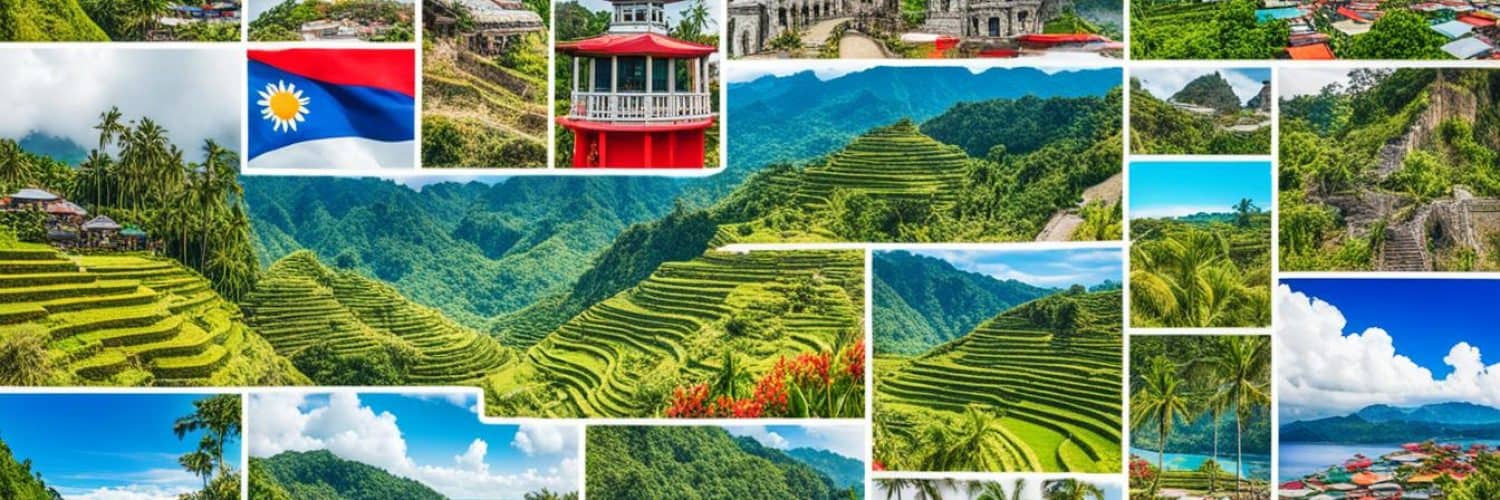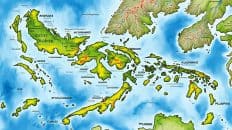The Philippines, a country known for its stunning beaches and vibrant culture, is also home to a linguistic treasure trove. Did you know that the Philippines boasts over 170 native languages? From the rolling hills of Luzon to the pristine shores of Mindanao, each region contributes its own unique dialect to the rich tapestry of Filipino languages.
So, what are these dialects in the Philippines, and how do they shape the country’s cultural landscape? Join us as we embark on a linguistic journey, delving into the evolution of language, the birth of the national language, and the role of indigenous languages in preserving heritage.
Key Takeaways:
- The Philippines is home to over 170 native languages, contributing to its linguistic diversity.
- Spanish colonization and American influence have played a significant role in shaping Filipino languages.
- The selection of Tagalog as the basis for the national language and its subsequent shift to Filipino reflects the country’s commitment to unity and embracing linguistic diversity.
- Tagalog, Cebuano, Ilocano, Waray-Waray, and Bikol are among the prominent native languages in the Philippines.
- The preservation and revitalization of indigenous languages are crucial in maintaining the country’s cultural heritage.
The Evolution of Language in the Philippines
Before Spanish colonization, the Philippines was already a diverse linguistic landscape with various indigenous languages spoken by different communities across the islands. These indigenous languages formed the foundation of communication and the preservation of cultural heritage.
The arrival of the Spanish in the 16th century brought significant changes to the linguistic landscape of the Philippines. Spanish became the language of administration, education, and the Church, greatly impacting the local languages.
The Spanish colonization influenced the Filipinos’ languages, resulting in the incorporation of many Spanish loanwords into indigenous languages. The assimilation of Spanish into native languages created a unique linguistic blend, giving rise to Filipino languages with a Spanish influence.
“The Spanish language played a vital role in shaping the linguistic diversity of the Philippines. Its impact can be seen in the vocabulary and grammar of Filipino languages,”
This linguistic fusion demonstrates the cultural syncretism that occurred during the colonial era. Even after Spanish rule ended, the influence of Spanish on Filipino languages remains apparent.
The image above reflects the vibrant tapestry of indigenous languages in the Philippines, each representing a unique cultural identity.
- Indigenous languages: The indigenous languages of the Philippines encompass a wide range of dialects spoken by different ethnic groups. These languages are an integral part of the country’s rich linguistic heritage and reflect the cultural diversity of its people.
- Colonial influences: The colonial history of the Philippines left a lasting impact on its languages. Spanish and English, as the languages of former colonial powers, have influenced Filipino languages through loanwords, grammar, and cultural practices.
- Continued evolution: Language in the Philippines continues to evolve as it adapts to modern influences, such as globalization and technological advancements. While English remains a widely spoken language, there is a growing movement to revitalize and preserve native languages.
Preserving the Indigenous Languages of the Philippines
The preservation of indigenous languages is crucial in maintaining the cultural heritage and identity of the Philippines. Efforts are being made to document, revitalize, and promote these languages through educational programs, research, and community initiatives.
“Preserving our native languages is a testament to our roots, our unique traditions, and our diverse cultural expressions.”
The Philippine government, in collaboration with linguists, indigenous communities, and language experts, has been working towards the documentation, standardization, and promotion of indigenous languages. Indigenous language programs aim to empower communities to preserve their languages and pass them on to future generations.
Despite the challenges faced in language preservation, such as urbanization and globalization, the dedication and determination of language advocates in the Philippines provide hope for the continued celebration and preservation of linguistic diversity in the country.
The Birth of Filipino as the Philippines' National Language
In the early 20th century, the Philippines was under American colonial rule, and it was during this time that English was introduced as the medium of instruction. However, the quest for a national language that could unite the diverse ethnic groups of the country led to the selection of Tagalog as the basis for Filipino. The goal was to create a lingua franca that would promote communication and education, while still acknowledging the cultural significance of Tagalog.
| Key Points | Details |
|---|---|
| Background | The Philippines was under American colonial rule in the early 20th century. |
| Medium of Instruction | English was introduced as the medium of instruction. |
| Unifying Ethnic Groups | Tagalog was chosen as the basis for Filipino to unite the diverse ethnic groups. |
| Lingua Franca | The goal was to create a lingua franca that promotes communication and education. |
| Cultural Significance | The selection of Tagalog as the basis for Filipino acknowledges the cultural significance of Tagalog. |
The birth of Filipino as the Philippines’ national language marked an important milestone in the country’s history. It provided a common language for communication and education, bridging the gap between different linguistic communities. While Tagalog formed the foundation for Filipino, it incorporated elements from other Philippine languages to accommodate the cultural diversity of the nation. Today, Filipino serves as a symbol of unity and pride, reflecting the rich linguistic and cultural heritage of the Filipino people.
The Shift from Pilipino to Filipino
In 1959, the Philippines officially designated its national language as “Pilipino,” aiming to create a language that incorporated words from various Philippine languages to emphasize inclusivity and linguistic diversity. However, this decision was not without controversy, as some felt that Pilipino leaned heavily towards Tagalog, the dominant language in the capital region.
“Language is the road map of a culture. It tells you where its people come from and where they are going.” – Rita Mae Brown
The shift from Pilipino to Filipino emphasizes the importance of embracing linguistic diversity and acknowledging the unique identities of different regions and communities within the country. It promotes a sense of unity while preserving the rich cultural heritage embedded in the Filipino language.

Comparison between Pilipino and Filipino
| Pilipino | Filipino |
|---|---|
| Official designation from 1959 to 1987 | Official designation since 1987 |
| Emphasized inclusivity and incorporation of words from different Philippine languages | Reflects a more accurate representation of the country’s identity and linguistic diversity |
| Some controversy over perceived dominance of Tagalog | Promotes unity while acknowledging regional diversity |
The transition from Pilipino to Filipino represents the ongoing efforts to embrace linguistic diversity and promote a stronger sense of Filipino identity. Filipino is a language that celebrates the cultural richness found within the Philippines, allowing for greater inclusivity and understanding in the diverse linguistic landscape of the country.
The Role of Filipino as the Official Language
Today, Filipino is recognized as the official national language of the Philippines. It plays a vital role in uniting the diverse ethnic groups and languages within the country. While Tagalog forms the foundation of Filipino, it incorporates elements from other Philippine languages, highlighting the nation’s commitment to embracing linguistic diversity.
By incorporating elements from various Philippine languages, Filipino creates a sense of belonging and recognition for different ethnic groups. This recognition promotes a shared identity and strengthens the bonds among Filipinos, regardless of their linguistic backgrounds.
The official language policy of the Philippines demonstrates a commitment to affirming the cultural heritage of its people. It acknowledges that language is more than just a means of communication; it is a reflection of a nation’s history, diversity, and collective identity.
“Language is the road map of a culture. It tells you where its people come from and where they are going.”
Native Languages of the Philippines
The linguistic diversity of the Philippines is truly remarkable, with over 170 native languages spoken throughout the archipelago. These indigenous languages reflect the rich cultural heritage and heritage of the Filipino people. Passed down through generations, these languages encapsulate traditional stories, customs, and ways of life unique to each community.
“Language is the key to understanding and preserving our cultural identity. Through our native languages, we connect with our ancestors and keep alive the traditions that define us as Filipinos.”
Among the prominent native languages in the Philippines are:
- Tagalog: The language predominantly spoken in the capital region of Manila and its surrounding areas. Tagalog serves as the foundation for the national language, Filipino, and is widely understood throughout the country.
- Cebuano: Spoken primarily in the Visayas region, Cebuano is one of the most widely spoken native languages in the Philippines. It has colorful expressions and vibrant cultural expressions.
- Ilocano: The major language in the northern part of the Philippines, particularly in the Ilocos region. Ilocano has a significant number of speakers and is known for its distinct linguistic features.
- Waray-Waray: Spoken in the Eastern Visayas region, Waray-Waray represents the rich linguistic tapestry of the country. It has its own unique expressions and literary traditions.
- Bikol: Hailing from the Bicol region, Bikol adds another layer of linguistic diversity to the Philippines. It possesses distinct vocabulary, grammar, and cultural identity.
These native languages provide insights into the historical and cultural contexts of diverse regions in the Philippines, fostering a profound sense of identity, belonging, and pride among their speakers.
Through the preservation and promotion of these native languages, the Philippines celebrates its linguistic heritage, ensuring the continuity of its diverse cultural expressions for generations to come.
Tagalog - The Foundation of Filipino
This native language is widely spoken, with millions of speakers across the country. It plays a crucial role in promoting effective communication and understanding among Filipinos. While Tagalog is the primary component of Filipino, the national language of the Philippines, it encompasses various regional variations and dialects that reflect the linguistic diversity within the country.
Regional Variations and Dialects of Tagalog
1. Manila Tagalog: Also known as Filipino Tagalog, it is the standard form of Tagalog and serves as the basis for the national language, Filipino.
2. Batangas Tagalog: Spoken mainly in the province of Batangas, this dialect features distinct intonation patterns and vocabulary.
3. Bulacan Tagalog: Commonly spoken in the province of Bulacan, this dialect is characterized by its melodic tone and unique vocabulary.
4. Quezon Province Tagalog: Found in the province of Quezon, this dialect is influenced by neighboring languages and exhibits notable variations in pronunciation.
These regional variations of Tagalog reflect the diverse cultures and identities within the Philippines, highlighting the rich tapestry of regional languages and dialects.
Regional Variations and Dialects of Tagalog
| Regional Variation | Location | Distinct Features |
|---|---|---|
| Manila Tagalog | Capital region of Manila and surrounding areas | Serves as the standard form of Tagalog and basis for Filipino |
| Batangas Tagalog | Province of Batangas | Distinct intonation patterns and vocabulary |
| Bulacan Tagalog | Province of Bulacan | Melodic tone and unique vocabulary |
| Quezon Province Tagalog | Province of Quezon | Influenced by neighboring languages, notable variations in pronunciation |

Cebuano - Widely spoken and Full of Life
Cebuano, also known as Bisaya, is one of the most widely spoken native languages in the Philippines. It is primarily spoken in the Visayas region, which includes popular tourist destinations such as Cebu, Bohol, and Dumaguete. With over 20 million speakers, Cebuano is a vibrant and dynamic language that reflects the rich cultural heritage of its speakers.
“Cebuano is not just a language; it encapsulates the spirit, traditions, and values of the Visayan people. It is a language that is full of life, warmth, and rich cultural expressions.” – Local Cebuano Speaker
With its widespread usage, Cebuano serves as a key language for communication, business, and daily interactions in the Visayas region. It is the language of choice for locals, enabling seamless conversations and fostering a strong sense of community.
Cebuano is also a language that embraces its diversity, with various dialects and regional variations. Some of the notable Cebuano dialects include Boholano, Hiligaynon, Waray-Waray, and Surigaonon, each with its own unique characteristics and vocabulary.
Prominent Features of Cebuano:
- Cebuano is known for its extensive vocabulary and expressive phrases, allowing speakers to convey their thoughts and emotions vividly.
- It is a language that thrives in oral tradition, with rich folklore, proverbs, and poetry that have been passed down through generations.
- Cebuano places importance on respect and politeness, with specific linguistic nuances to address different levels of formality and social status.
- Like many Philippine languages, Cebuano incorporates loanwords from Spanish, English, and other languages, reflecting the country’s complex history and cultural interactions.
Whether you’re exploring the beautiful beaches of Cebu, attending a vibrant fiesta in Bohol, or immersing yourself in the rich heritage of the Visayas region, learning a few Cebuano phrases can enhance your experience and connect you with the local culture.
Immerse yourself in the lively and expressive world of Cebuano, and discover the heart and soul of the Visayas region through its language.
Ilocano - Language of the North
Ilocano, also known as “Ilokano,” is a major language spoken in the northern part of the Philippines, particularly in the Ilocos region. It has a significant number of speakers and is known for its distinct linguistic features. The Ilocano community holds an important place in Philippine history and culture.
With its roots deeply embedded in the northern Philippines, the Ilocano language reflects the rich heritage of the region. It has been passed down through generations, preserving the traditions, customs, and wisdom of the Ilocano people.
Ilocano exhibits its unique characteristics through its grammar, vocabulary, and pronunciation. This language has a melodic quality, captivating listeners with its cadence and intonation. The Ilocano language is renowned for its expressions of love, longing, and resilience, encapsulating the spirit and identity of the Ilocano people.
Ilocano Dialects
- Iloko ti La Union: Spoken in the province of La Union
- Iloko ti Abra: Spoken in the province of Abra
- Iloko ti Ilocos Norte: Spoken in the province of Ilocos Norte
- Iloko ti Ilocos Sur: Spoken in the province of Ilocos Sur
- Iloko ti Bulacan: Spoken in the province of Bulacan
While dialectal differences exist, mutual intelligibility among Ilocano speakers ensures effective communication across these variations. This linguistic unity among the Ilocano community contributes to the overall vitality and preservation of the Ilocano language.
âThe Ilocano language carries with it the stories, history, and cultural identity of our people. It is through our language that we express our values, customs, and aspirations. We take pride in preserving and promoting the richness of the Ilocano language.â – Juan dela Cruz, a respected Ilocano language advocate.
Despite the challenges posed by globalization and modernization, the Ilocano community’s commitment to embracing their language remains resolute. Efforts are underway to document and revitalize the Ilocano language, ensuring its continuity and further enriching the diverse linguistic landscape of the Philippines.
| Ilocano | English |
|---|---|
| Naragsak | Beautiful |
| Agsapa | Friend |
| Pagsasaritaan | Conversation |
| Penged | Hardworking |
| Sabong | Cockfight |
These are just a few examples of the rich vocabulary and expressions found in the Ilocano language. Each word carries a unique cultural significance, reflecting the Ilocano people’s deep connection to their land, history, and traditions.
Waray-Waray - A Voice from the East
The Waray-Waray language, also known simply as Waray, holds a significant place in the cultural heritage of the Eastern Visayas region. It is spoken by the Waray people, who have a rich history and vibrant cultural traditions.
The Waray-Waray language reflects the influences of the region’s history and geography. Throughout the years, it has absorbed elements from indigenous languages, as well as Spanish and English, creating a distinctive linguistic identity.
Waray-Waray is characterized by its melodic intonation and rhythmic patterns, which add depth and beauty to the spoken word. It is also known for its rich oral traditions, including folklore, poetry, and epic narratives that have been passed down from generation to generation.
Waray culture is intricately woven into the fabric of everyday life, and the language reflects this cultural richness. Through the Waray-Waray language, stories are told, songs are sung, and traditions are preserved.
Explore the fascinating Waray-Waray language and immerse yourself in the vibrant culture of the Eastern Visayas region.

Waray-Waray Language Characteristics
Here are some key characteristics of the Waray-Waray language:
- Waray-Waray belongs to the Central Philippine branch of the Austronesian language family.
- It is closely related to the Cebuano language and shares many similarities.
- Waray-Waray has its own unique vocabulary and grammar, setting it apart from other Philippine languages.
- It has a rich set of affixes and suffixes, allowing for the creation of new words and expressions.
- The language has different dialects and variations across the Eastern Visayas region.
Learn more about the Waray-Waray language and discover the linguistic diversity of the Philippines.
Bikol - Unveiling Southern Expressions
The Bicol region in the Philippines is home to the fascinating Bikol language, which adds an additional layer of linguistic diversity to the country. Bikol is known for its distinct vocabulary, grammar, and cultural identity, making it a significant component of the Bicol region’s rich heritage.
Bikol plays a crucial role in preserving and conveying local stories, folklore, and traditional knowledge. It serves as a medium through which the culture, history, and values of the Bicolanos are passed down from generation to generation.
The Bikol language is a reflection of the region’s unique character and embody the essence of the Bicolano people. Through its vibrant expressions, Bikol captures the vivid imagery, playful idioms, and melodic cadence that form the cultural tapestry of the Bicol region.
The significance of the Bikol language extends beyond its linguistic and cultural aspects. It fosters a sense of unity and identity among the Bicolanos, connecting them through their shared dialects and expressions. Speaking Bikol becomes an acknowledgment of being part of the vibrant Bicolano community and a celebration of their heritage.
“Bikol language is not just the words we speak; it is a testament to our resilience, our stories, and our sense of belonging. It unites us as Bicolanos and enables us to preserve our rich cultural heritage for future generations to come.” – Bicolano proverb
The preservation and promotion of the Bikol language are essential in maintaining the cultural identity of the Bicol region. Efforts are being made to document and revitalize the language, ensuring its continuity in the face of modernization and evolving language trends.
The Diversity of Bikol Dialects
Bikol encompasses various dialects that reflect the geographical and cultural nuances within the Bicol region. Some of the notable Bikol dialects include:
- Bikol Rinconada – spoken in the province of Camarines Sur
- Bikol Albayano – spoken in the province of Albay and parts of Sorsogon
- Bikol Pandan – spoken in the towns of Pandan and Virac in Catanduanes
Each dialect possesses its own distinct vocabulary, pronunciation, and grammatical features, enabling Bicolanos to identify their origin within the expansive Bicol region.
| Dialect | Province |
|---|---|
| Bikol Rinconada | Camarines Sur |
| Bikol Albayano | Albay and parts of Sorsogon |
| Bikol Pandan | Pandan and Virac in Catanduanes |
The table above showcases some of the Bikol dialects and their corresponding provinces within the Bicol region.
The Bikol language stands as a testament to the rich cultural heritage of the Bicolanos. Its distinct expressions, dialects, and cultural significance are an integral part of the Philippines’ linguistic diversity, reflecting the resilience and vibrancy of its people.
The Most Spoken Languages of the Philippines
While native languages are essential to the cultural fabric of the Philippines, certain languages have gained prominence due to historical and social factors. Among these, English and Spanish have played significant roles in shaping the linguistic landscape of the country.
English, as a remnant of American colonial rule, has become a widely spoken language in the Philippines. It serves as a common medium of communication, particularly in business, education, and the global sphere. Its prevalence has propelled the country’s integration into the international community and facilitated opportunities for Filipinos around the world.
Spain’s historical influence is still evident in Filipino languages through Spanish loanwords and cultural influences. While Spanish is no longer widely spoken, it has left a lasting impact on the linguistic heritage of the country. Spanish words and expressions continue to enrich Filipino languages, demonstrating the enduring connections between the Philippines and its colonial past.
| Language | Primary Speakers |
|---|---|
| English | Approximately 70 million |
| Tagalog (Filipino) | Approximately 45 million |
| Cebuano | Approximately 20 million |
| Ilocano | Approximately 9 million |
| Waray-Waray | Approximately 4 million |
| Bikol | Approximately 3 million |
Source: Ethnologue 2021
Efforts to Preserve and Revitalize Philippine Native Languages
Recognizing the importance of language preservation, the Philippine government has implemented various laws and programs to document, preserve, and revitalize the linguistic diversity in the country. These initiatives aim to protect and promote the native languages that form an integral part of the Filipino cultural heritage.
Organizations and institutions are working closely with indigenous communities to create language materials and educational resources. These materials include dictionaries, grammar books, and teaching guides that help in the preservation and revitalization of indigenous languages. Through collaborations with linguists and community leaders, these efforts ensure accurate documentation and provide valuable resources for language learners and educators.
Language is not just a means of communication; it is a vessel that carries the history, traditions, and identity of a community. By revitalizing native languages, we breathe life into our cultural heritage and strengthen our cultural resilience.
Indigenous language programs and initiatives have been established to further promote the use and appreciation of native languages. These programs often include language immersion classes, cultural events, and community-based language preservation activities. By creating environments that encourage native language use, these initiatives foster a sense of pride and belonging among community members.
The Philippine government also recognizes the importance of integrating native languages into the education system. Efforts are being made to develop curriculum materials that incorporate indigenous languages, ensuring that they are taught alongside Filipino and English. This approach not only promotes language revitalization but also helps students connect with their cultural roots.
Example of Indigenous Language Program:
| Program Name | Description | Location |
|---|---|---|
| Language Revitalization Project | A community-led project that focuses on preserving and revitalizing the indigenous language through language documentation, curriculum development, and cultural events. | Kalinga Province |
| Language Immersion Program | An immersive language program that provides children the opportunity to learn the native language in a natural and authentic setting, emphasizing practical language use and cultural experiences. | Iloilo City |
| Cultural Exchange Program | A collaborative program that brings together indigenous communities and schools to promote cultural exchange, including language workshops, performances, and dialogue sessions. | Davao del Sur |
These language preservation efforts not only contribute to the linguistic diversity of the Philippines but also empower indigenous communities, helping them to preserve their cultural identity and heritage. They ensure that future generations have access to their native languages, thereby fostering a sense of pride and connection to their ancestors.
Through continuous support and collaboration, we can revitalize and celebrate the wealth of native languages in the Philippines, ensuring their preservation for generations to come.
Challenges in Filipino Native Language Preservation
Despite ongoing efforts, the preservation of native languages in the Philippines faces a range of challenges. Two major factors influencing this issue are the impact of globalization and the effects of urbanization on language diversity.
In today’s interconnected world, globalization plays a significant role in shaping languages. As societies become more interconnected, younger generations may prioritize learning languages perceived as more cosmopolitan or economically advantageous. This preference can result in a decline in the use and preservation of traditional native languages.
Globalization and urbanization pose threats to traditional languages, as younger generations may prefer languages perceived as more cosmopolitan or economically advantageous.
However, it is crucial to maintain the linguistic heritage of the Philippines. Native languages carry historical, cultural, and social significance, reflecting the diverse identities and traditions of different communities. Ensuring the continuity of these languages is essential for preserving cultural diversity and fostering a sense of identity among the Filipino population.
Efforts to address these challenges must focus on raising awareness about the importance of language preservation and advocating for support from policymakers, educators, and the wider community. Education plays a pivotal role in language preservation, as it empowers individuals to appreciate and actively use their native languages.
By embracing the linguistic diversity of the Philippines, communities can promote inclusive communication and celebrate the richness of their cultural heritage.
Key Challenges:
- The influence of globalization on language preferences
- The impact of urbanization on language diversity
Addressing these challenges requires a collective effort from individuals, communities, and institutions. It involves celebrating and promoting the use of native languages, creating educational resources, supporting language revitalization programs, and fostering a deeper appreciation for the linguistic diversity that defines the Philippines.
Preserving Linguistic Heritage
In order to overcome these challenges, ongoing awareness campaigns, language revitalization initiatives, and policy support are needed. By recognizing the value of native languages and embracing linguistic diversity, the Philippines can ensure the preservation of its unique linguistic heritage.
Find Philippines Languages Translations Near You!
When you require professional translation services for languages in the Philippines, look no further than PoliLingua. As a reputable translation company in the Philippines, PoliLingua offers accurate translations in a variety of languages, including Filipino, Spanish, English, and more. With their expertise and global reach, they are the ideal choice for effective communication and bridging linguistic barriers.
Whether you need documents translated for business, legal, or personal purposes, PoliLingua’s team of experienced translators can provide high-quality translations tailored to your specific needs. They understand the nuances and cultural intricacies of the Filipino language and ensure that translations accurately convey the original meaning while maintaining cultural sensitivity.
By partnering with a professional translation company in the Philippines like PoliLingua, you can trust that your translations will be handled by language experts who are well-versed in the complexities of the Filipino language. Their commitment to delivering reliable translations will help you effectively communicate with your target audience, whether they are local residents or international clients.
Don’t let language barriers limit your reach in the Philippines. Contact PoliLingua today for all your translation needs.
Conclusion
The linguistic diversity of the Philippines is a true reflection of the country’s rich history, cultural tapestry, and unyielding spirit. With over 170 native languages spoken across the archipelago, the Philippines stands as a unique testament to the power of language as a cultural heritage.
From the indigenous languages that have thrived for centuries to the influence of Spanish and English, the Philippines embraces its linguistic diversity as a source of national pride. Each region boasts its own distinct dialects, contributing to the vibrant linguistic tapestry that defines the Philippines.
Preserving and promoting native languages is paramount in safeguarding the cultural heritage of the Philippines. It is through these languages that traditional stories, customs, and ways of life are passed down through generations. The continued efforts to document, revitalize, and promote linguistic diversity ensure that the voices of the Filipino people will continue to resonate and flourish.
In a world of globalization and urbanization, upholding the significance of native languages poses its challenges. However, by raising awareness, providing educational resources, and fostering a sense of linguistic pride, the Philippines can safeguard its linguistic diversity for future generations. Language remains a pivotal cultural heritage, and the Philippines stands as a shining example of the power and beauty found in linguistic diversity.
FAQ
How many dialects are spoken in the Philippines?
The Philippines is known for its linguistic diversity, with over 170 native languages spoken across the archipelago.
What influenced the dialects in the Philippines?
The country’s dialects are influenced by its complex history, including colonization by Spain and the United States.
What languages were spoken in the Philippines before Spanish colonization?
How did Spanish colonization impact the Filipino languages?
The arrival of the Spanish in the 16th century brought significant changes to the linguistic landscape, as Spanish became the language of administration, education, and the Church.
When was English introduced as a medium of instruction in the Philippines?
English was introduced as the medium of instruction during the early 20th century when the Philippines was under American colonial rule.
What is Filipino, and why was Tagalog chosen as its basis?
Filipino is the national language of the Philippines, and it was based on Tagalog to create a lingua franca that could unite the diverse ethnic groups of the country.
How did the national language evolve from Pilipino to Filipino?
In 1959, the national language was officially designated as “Pilipino,” but it was later revised to “Filipino” in 1987 to reflect the country’s identity and linguistic diversity accurately.
What role does Filipino play in the Philippines?
Filipino is recognized as the official national language and plays a vital role in uniting the diverse ethnic groups and languages within the country.
How many native languages are there in the Philippines?
The Philippines is home to over 170 native languages, each with its own cultural significance and unique characteristics.
What is the most widely spoken native language in the Philippines?
Tagalog is the most widely spoken native language in the Philippines, predominantly spoken in the capital region of Manila and its surrounding areas.
What are some other prominent native languages in the Philippines?
Other prominent native languages in the Philippines include Cebuano, Ilocano, Waray-Waray, and Bikol.
What is the significance of Cebuano in the Philippines?
Cebuano is another widely spoken native language in the Philippines, primarily in the Visayas region, known for its vibrant cultural expressions and linguistic richness.
Where is Ilocano spoken in the Philippines?
Ilocano is a major language spoken in the northern part of the Philippines, particularly in the Ilocos region.
What are some prominent dialects in the Philippines?
Some prominent dialects in the Philippines include Tagalog, Cebuano, Ilocano, Waray-Waray, and Bikol.
How are efforts made to preserve native languages in the Philippines?
The Philippine government has implemented various laws and programs to document, preserve, and revitalize linguistic diversity in the country.
What are some challenges in preserving native languages in the Philippines?
Challenges in preserving native languages in the Philippines include globalization, urbanization, and the preference for languages perceived as more cosmopolitan or economically advantageous.
Where can I find Philippines language translations?
Reputable translation companies like PoliLingua can provide accurate translations in various languages, including Filipino, Spanish, and English.
What is the significance of linguistic diversity in the Philippines?
The linguistic diversity in the Philippines reflects the country’s rich history, cultural diversity, and resilience, serving as a cultural heritage.














Add comment